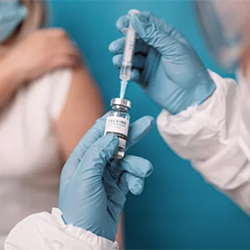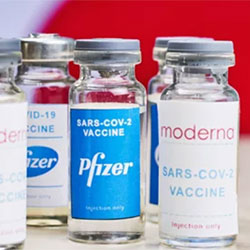By Marie Rosenthal, MS
Faced with a mutating SARS-CoV-2 virus, public health officials looked to their yearly campaign against influenza as a guide to increase immunity against the cause of COVID-19, explained Kathryn M. Edwards, MD, the Sarah H. Sell and Cornelius Vanderbilt Chair and scientific director of the Vanderbilt Vaccine Research Program at Vanderbilt University, in Nashville, Tenn.

Because influenza mutates every year, public health officials throughout the world monitor the virus to predict the course the next influenza season will take. They use that prediction to create the next season’s influenza vaccination, before those strains are circulating. Based on these prediction models, the 2022-2023 seasonal vaccine required changes in two components, but two others remain the same as previous seasons, according to the CDC (MMWR Morbid Mortal Wkly Rep 2022;71[29]:913-919).
“It is important to understand that because we have so much experience with how this works with influenza, which is also a respiratory virus, that the FDA and the ACIP [Advisory Committee on Immunization Practices] have been planning all along for the potential to need to add several different antigens to the [COVID-19] vaccine,” Dr. Edwards explained at a briefing sponsored by the Infectious Diseases Society of America. “The flu prototype is being used to show us how we do this.”
On Aug. 31, the FDA amended the emergency use authorization for the two messenger RNA (mRNA) COVID-19 vaccines developed by Moderna and Pfizer-BioNTech to authorize the use of bivalent formulations for a single booster dose at least two months after the primary series or booster vaccination. The boosters contain mRNA components of SARS-CoV-2 virus: one of the original strain of SARS-CoV-2 and the other one in common between the BA.4 and BA.5 lineages of the omicron variant of SARS-CoV-2. On Sept. 1, the CDC endorsed the ACIP’s recommendation to use these updated boosters.
There has been some concern about the sublineage used in the bivalent boosters. The boosters that underwent human testing contained BA.1 and the original Wuhan strain, but the boosters authorized by the FDA contain the original Wuhan strain and the BA.4 and BA.5 strains. These antigens were found effective in animal models, but not tested in people because the BA.4 and BA.5 strains were not yet circulating when the vaccines were studied. So, just as is done for the influenza vaccine every year, the FDA is trying to predict the next wave and provide a vaccine that’s more closely aligned with the circulating strains, explained Walter Orenstein, MD, a professor and the associate director at the Emory Vaccine Center at Emory University, in Atlanta. Dr. Orenstein appeared at the briefing with Dr. Edwards.
“One of our challenges is that this virus mutates and changes, and our immune response is focused on an area of the virus that can change and evade it,” added Dr. Orenstein, who is also an infectious disease professor of medicine at Emory, and the director of the Emory-UGA Center of Excellence for Influenza Research and Response.
This ability to evolve to evade the body’s immune system differs from viruses like measles and polio, which is why the vaccines against these diseases do not need to be updated.
“For influenza, and now with SARS-CoV-2, the cause of COVID-19 disease, we have to update our vaccines because the virus changes and evades it,” he said.
The bivalent boosters consist of half the dose of the original strain and half the dose of the new BA.4 and BA.5 strains, “so the amount of antigen is the same as the original vaccines that only contain the original strain,” he said.
“I do not want people to be unhappy or worried that the bivalent vaccine will act in a different way than the one that we have been administering for the past two years. It is the same structure. It has been studied in the same way. The safety signal should be identical, and we should feel good that we have chosen to have a vaccine that is going to contain the contemporary circulating strains,” Dr. Edwards explained.
Yearly Boosters?
What is still unknown is whether regular, possibly annual, boosters will be needed, and that is something that public health officials are considering. At the Sept. 6 White House COVID-19 Response Team briefing, Anthony Fauci, MD, the director of the National Institute of Allergy and Infectious Diseases, said that was a distinct possibility.
“It is becoming increasingly clear that, looking forward with the COVID-19 pandemic, in the absence of a dramatically different variant, we likely are moving toward a path with a vaccination cadence similar to that of the annual influenza vaccine, with annual, updated COVID-19 shots matched to the currently circulating strains for most of the population.
“However, some—particularly vulnerable groups—may continue to need more frequent vaccination against COVID-19,” he said, meaning that older people and those with immunocompromising conditions might need boosters more than once a year.
“More than 600 million doses of mRNA vaccines have been administered in the United States alone, with billions more given to people globally,” he said. “Through robust safety monitoring systems, we now have an extensive body of safety data as good or better than what we have for any prior vaccine. In addition, in clinical trials, more than 1,700 people have received bivalent mRNA vaccines with no additional safety concerns.”
In addition, data from the pivotal clinical trials for the original mRNA vaccines in 2020 showed the vaccines were between 94% and 95% effective against symptomatic disease, which Dr. Fauci called “remarkable.”
However, real-world evidence showed that the protection wanes over time, particularly against infection, although they were still effective in preventing hospitalizations and deaths. During the trials, the bivalent boosters “induced higher antibody titers against omicron than did the original vaccines,” he added.
“These bivalent vaccines also induced higher antibody titers against all SARS-CoV-2 variants than did the original vaccines,” Dr. Fauci explained. “In addition, the bivalent vaccines induced even higher levels of neutralizing antibodies in individuals who have recovered from COVID-19.”
Therefore, these vaccines should offer better protection against circulating strains, according to Ashish Jha, MD, the White House COVID-19 Response coordinator, who also said barring any unseen events, Americans should expect annual boosters.
“Barring any new variant curveballs—we’ve seen curveballs—but barring those variant curveballs, for a large majority of Americans, we are moving to a point where a single annual COVID shot should provide a high degree of protection against serious illness all year. That’s an important milestone.
“Let be clear: For our highest-risk individuals—and here, I’m thinking about my elderly parents, for instance, who are in their 80s, or one of my close friends who recently had a liver transplantation—individuals like that may need more than annual protection,” Dr. Jha said.
Dr. Edwards said it would be wonderful if the degree of immunity from the boosters lasted a year, but that remains to be seen. If more people are vaccinated with bivalent vaccine, “we may have less evolution of the virus,” she said, which could support annual boosters.
“There are two things that can happen,” Dr. Orenstein said. “One is immunity can wane—just get exhausted, and that happens with some vaccines. The second is the virus can mutate and evade the immune response. So, those are the two factors to consider about how often we need boosters and how often we need to change the contents of the boosters.”
As it has for some time, omicron continues to be the dominant circulating strain, with the BA.5 sublineage accounting for almost 90% of strains in circulation, according to the CDC. And this is the reason why the FDA decided to go with bivalent vaccines against BA.4 and BA.5, rather than BA.1, which other countries are using.
Dr. Edwards, who admitted she is not a microbiologist and could not determine how different BA.5 was from BA.1, said the serological responses to the BA.4-BA.5 vaccines were better than BA.1.
“It’s clear from the immunology data in the mice, that those mice that are given the .4 and .5 vaccine, as opposed to the BA.1, have a much more robust immune response to BA.4 and BA.5. So, it does seem that if you have a circulating strain being BA.4 and BA.5, hitting it with the appropriate vaccine targeted for that would be the most immunogenic,” she said in response to a question from Infectious Disease Special Edition.
“For me and my family, I want to get the vaccine that contains the current circulating strain and not the past one,” Dr. Orenstein said.
“The bottom line for me is I want to get it myself,” Dr. Orenstein added, which he hoped to accomplish before traveling to a meeting at the World Health Organization.




